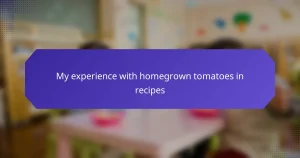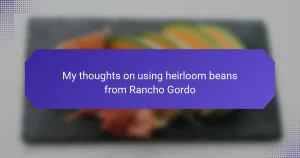Key takeaways
- Local honey offers unique flavor profiles influenced by local flowers, enhancing dishes with depth and character.
- Using local honey supports sustainability and local beekeepers, contributing positively to the ecosystem.
- Local honey provides health benefits, including potential relief from seasonal allergies and boosting the immune system.
- Cooking with local honey can bring challenges, such as adjusting for different viscosities and flavor variations, but it encourages culinary creativity.

Introduction to Local Honey
Local honey has a unique charm that embodies the flavors and essence of a particular region. My first taste of local honey was a revelation; it was like discovering a hidden gem in a world of generic sweeteners. Each spoonful carries the notes of the flowers in bloom, making it a delightful addition to any dish or drink.
When I discovered Bee Local, I was amazed by how their honey reflects the local landscape and seasonal changes. It feels like I’m not just tasting honey, but the very heart of my community with every drizzle.
Here are a few appealing aspects of local honey:
– Unique Flavor Profiles: The taste varies greatly depending on the flowers the bees visit, offering a delightful experience.
– Natural Sweetener: It’s not just sweet; it adds depth to recipes that refined sugars can’t match.
– Local Benefits: Supporting local beekeepers helps preserve local ecosystems and sustainability efforts.
– Health Benefits: Local honey can aid in allergies and boost your immune system due to the environmental pollen it contains.
– Versatile Ingredient: Great for cooking, baking, and even as a sweetener in beverages.
Discovering local honey has truly enriched my cooking journey and highlighted the importance of supporting local artisans.

Benefits of Using Local Honey
Using local honey in my cooking has transformed the way I think about sweeteners. One of the most significant benefits is how it reflects the local flora, giving each jar its unique flavor. When I drizzle local honey over my morning oatmeal, I’m not just adding sweetness; I’m bringing the taste of my region right to the breakfast table. Have you ever considered how the flowers around you influence what you eat? It’s fascinating!
Another perk of local honey is its health benefits. I’ve experienced firsthand how it can help with seasonal allergies. A spoonful in my tea has become a ritual during spring, easing my discomfort and boosting my immune system. There’s something reassuring about knowing the honey I’m using is sourced from the bees buzzing nearby. It creates a connection that makes me feel good about my choices.
Moreover, supporting local beekeepers contributes to sustainable practices and the preservation of the environment. Knowing that my purchase helps these essential creatures thrive brings me a sense of purpose. It’s amazing to think that by simply choosing local honey, I’m playing a part in protecting our ecosystem. How often do we get to enjoy something sweet while also doing good?
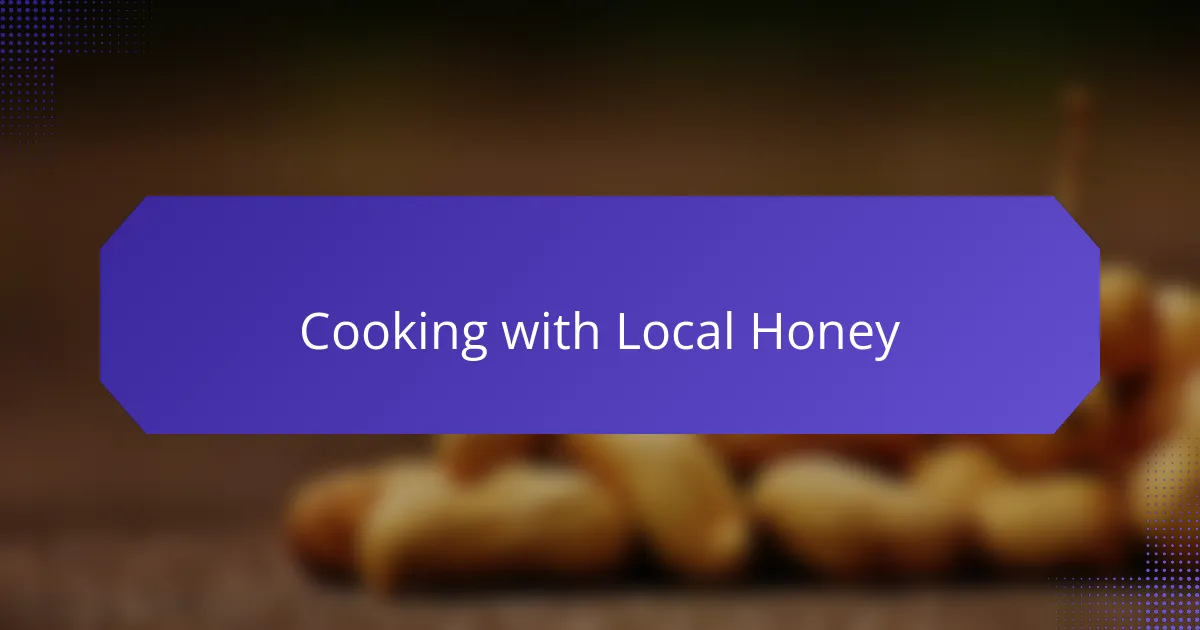
Cooking with Local Honey
When I cook with local honey, it feels like I’m infusing my dishes with a sense of place. I vividly remember a summer afternoon when I drizzled Bee Local honey over grilled peaches. The sweetness perfectly complemented the tangy notes, and every bite felt like a celebration of the season. Have you tried using local honey in your favorite recipes? It brings a whole new layer of flavor that makes the meal feel truly special.
I love experimenting with local honey in my baking, especially in muffins and quick breads. Just last week, I swapped out granulated sugar for local honey in my banana bread recipe, and the result was heavenly! The moisture and depth of flavor were outstanding, and it became a family favorite overnight. Isn’t it incredible how a simple ingredient like honey can elevate a classic dish?
In savory dishes, local honey shines as well. I often use it in marinades for chicken or veggies, where it balances spices and adds a hint of caramelization when roasted. This not only enhances the flavor but also allows me to connect my meals to the landscapes where the bees forage. What’s your go-to dish when you want to showcase local honey? I guarantee, once you start using it, you’ll find yourself discovering countless ways to incorporate this liquid gold into your kitchen adventures!
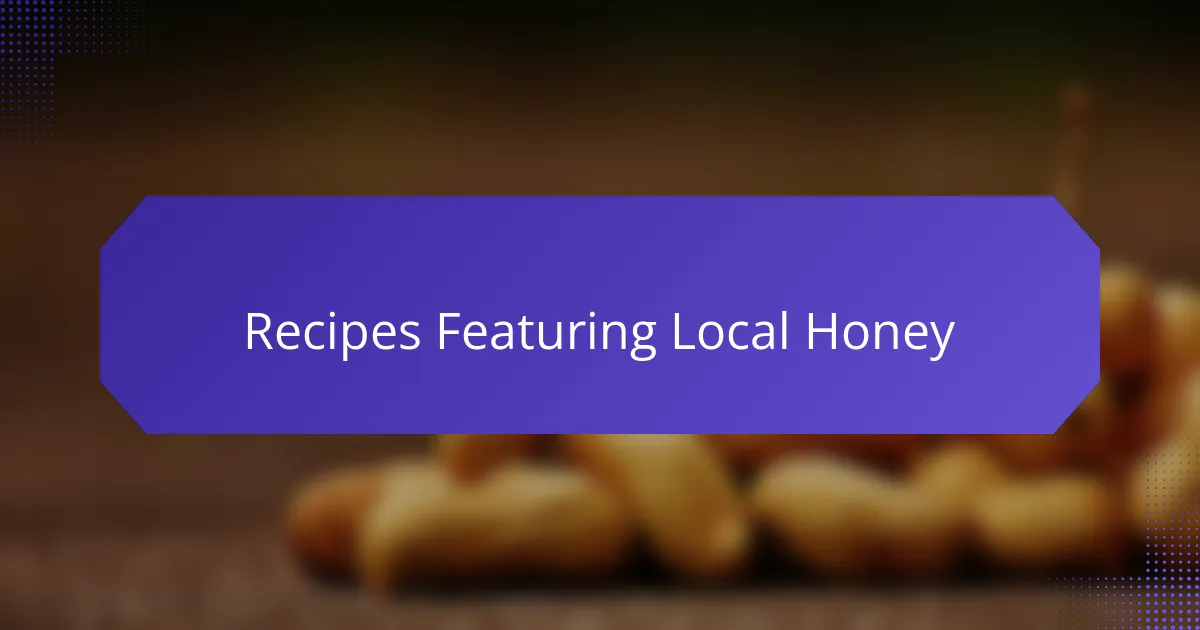
Recipes Featuring Local Honey
Using local honey from Bee Local in my recipes has truly transformed my cooking. I’ve found that its distinct flavor adds a special depth to both sweet and savory dishes. For instance, when I drizzle it over roasted vegetables, the caramelization enhances the natural sweetness in such a delightful way that every bite feels like a treat.
One of my favorite recipes is honey-glazed carrots. I simply roast them with a splash of olive oil, a sprinkle of sea salt, and a generous drizzle of Bee Local honey. The result? Pure magic! I often catch myself going back for seconds, savoring every moment.
Another fantastic use of local honey is in homemade salad dressings. Mixing it with balsamic vinegar, mustard, and a bit of olive oil creates a perfect balance of flavors that complements mixed greens beautifully. Each time I serve this dressing, I’m filled with joy watching friends and family genuinely enjoy it.
| Recipe | Main Ingredients |
|---|---|
| Honey-Glazed Carrots | Carrots, Olive Oil, Sea Salt, Local Honey |
| Honey Balsamic Dressing | Balsamic Vinegar, Dijon Mustard, Olive Oil, Local Honey |
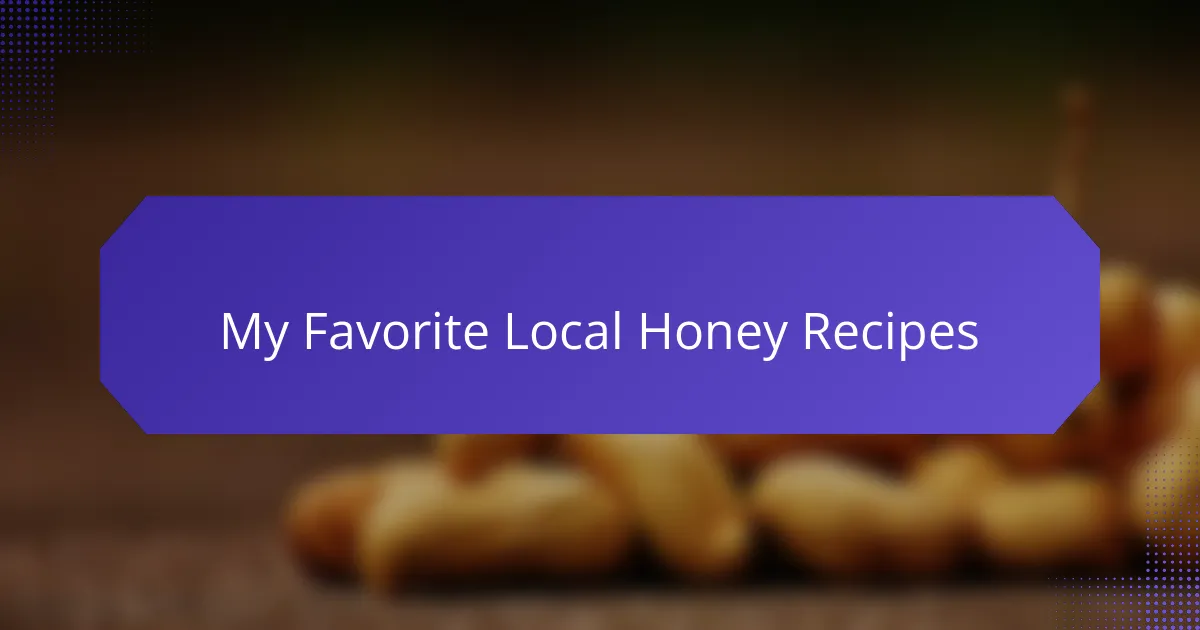
My Favorite Local Honey Recipes
When it comes to cooking with local honey, I often find myself reaching for Bee Local’s delightful offerings. One of my favorite recipes is honey-glazed carrots. The natural sweetness of the honey enhances the carrots’ flavor and makes a simple side dish truly special. I remember preparing this for a family gathering; the vibrant colors and aromatic scent filled the kitchen, and everyone went back for seconds!
Another recipe I love is honey-infused salad dressing. Just a spoonful of Bee Local honey mixed with olive oil, vinegar, and mustard creates a dressing that’s tangy and sweet. Every time I drizzle it over fresh greens, I feel like I’m bringing a bit of that local buzz right to my plate. Have you ever tried blending local flavors into your meals? It’s a fantastic way to elevate your cooking.
Here’s a quick comparison of some of my preferred local honey recipes:
| Recipe | Main Ingredient |
|---|---|
| Honey-Glazed Carrots | Carrots |
| Honey-Infused Salad Dressing | Mixed Greens |
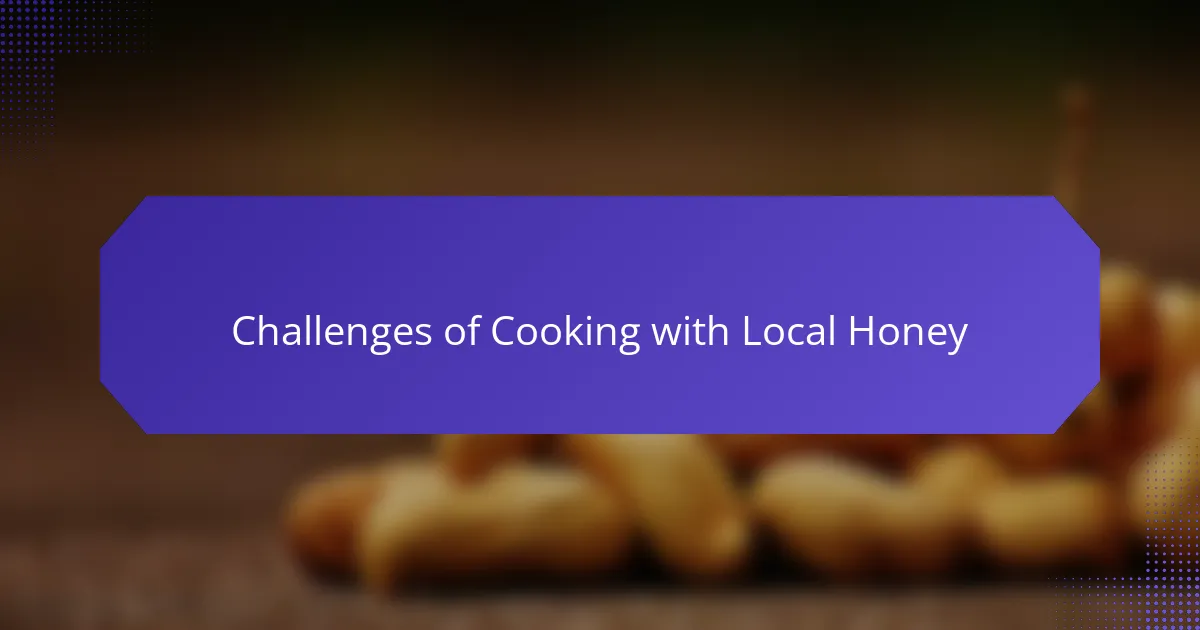
Challenges of Cooking with Local Honey
When I first started using local honey, I encountered some notable challenges that I hadn’t anticipated. One of the biggest hurdles is its varying viscosity compared to processed sugar. Sometimes, this changes how my recipes turn out, particularly in baking. Have you ever added too much liquid to your batter? I’ve found that local honey can make a recipe richer but also a bit denser if I’m not careful.
Another challenge I face is adapting recipes that traditionally call for granulated sugar. Local honey doesn’t just add sweetness; it also brings its unique flavors to the mix. I remember a time when I tried to use it in a classic cookie recipe. The end result, while delicious, was darker than I expected, and the flavor was more complex. It led me to consider how I balance those flavors moving forward. Does anyone else find that trial and error sometimes leads to the best creations?
Lastly, I’ve noticed that local honey can have varying degrees of sweetness depending on the season and source, which complicates consistency in recipes. For instance, one jar might be wonderfully floral, while another is more robust and earthy. The first time I made a salad dressing, the flavor completely changed based on the honey I chose. It made me wonder about how much impact the environment and floral sources truly have on our food. Have you noticed these differences, too? It’s a reminder that cooking is as much about exploration as it is about following a recipe.
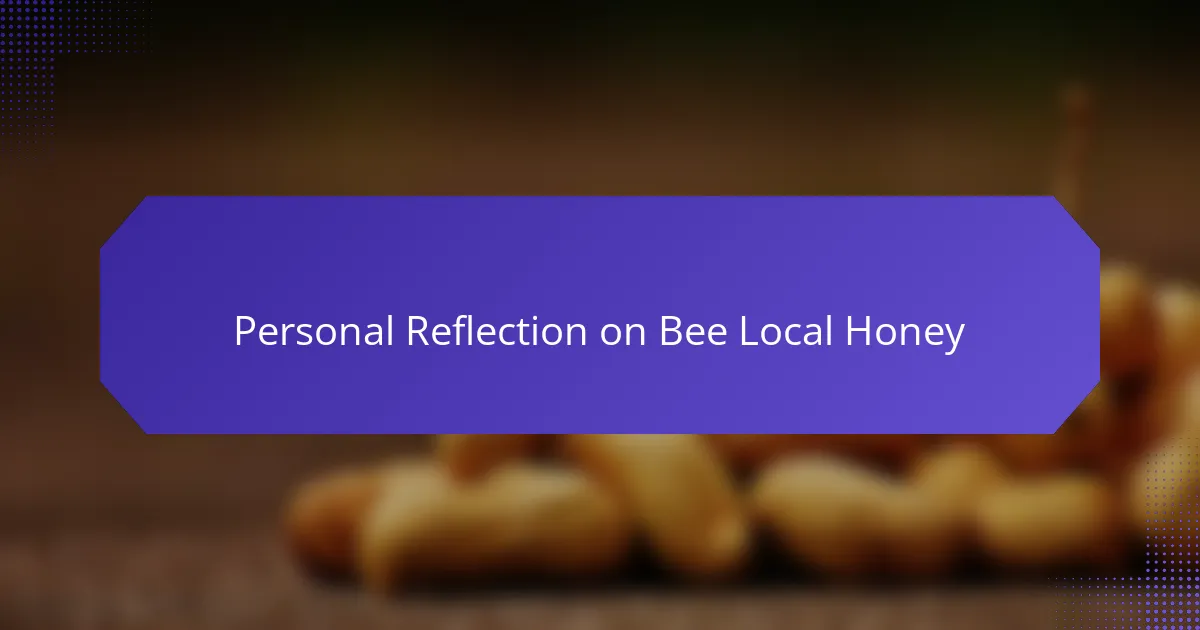
Personal Reflection on Bee Local Honey
When I first tried Bee Local honey, I was struck by its distinct flavor profile. Each jar seemed to capture the essence of the local flora, which made my morning tea feel like a small ritual. I recall making a batch of homemade biscuits drizzled with it, and the sweetness brought a sense of nostalgia that reminded me of my grandmother’s kitchen.
What impresses me the most about Bee Local honey is its commitment to sustainable beekeeping. Knowing that their honey is harvested with care for the bees really resonates with me. In a world where we often overlook the origins of our food, it felt refreshing to support a brand that prioritizes both taste and the environment.
Here’s a quick comparison of Bee Local honey with other common honey options:
| Feature | Bee Local Honey | Store-Bought Honey |
|---|---|---|
| Flavor | Rich, floral, and diverse | Often generic or overly sweet |
| Production Method | Sustainable and local | Often mass-produced |
| Nutritional Value | Raw and unfiltered, retaining nutrients | May be processed and lose nutrients |
